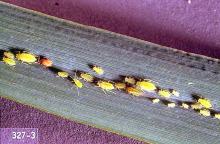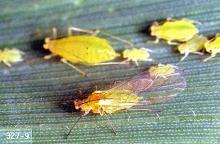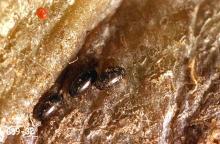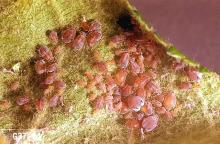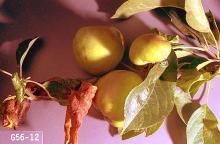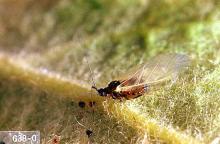Includes
Apple grain aphid (Rhopalosiphum oxyacanthae)
Apple aphid or green apple aphid (Aphis pomi)
Rosy apple aphid (Dysaphis plantaginea)
See also: woolly apple aphid
Pest description and crop damage The apple grain aphid is light green with a distinctive green stripe down the middle of the back. Apple grain aphids infest apple buds in the early part of the season, often becoming apparent at the green tip. Apple grain aphid is typically not economically damaging, and its early appearance may jumpstart aphid natural enemy populations. The green apple aphid is dark green and is present throughout the growing season on foliage. It may be more problematic on green and yellow apple cultivars. Heavy populations can feed directly on the fruit, which can mark fruit, or honeydew from this aphid can cause sooty mold growth.
Rosy apple aphids are rose-purple. Their feeding causes severe leaf curling, along with honeydew and sooty mold. Fruits of certain varieties can be stunted and deformed by early-season feeding. The best time for control is before bloom. Once leaves are severely curled, aphids are extremely difficult to kill.
Scouting and thresholds Begin observing growing shoots in late May as shoot leaves are expanding rapidly. Checking four to five infested leaves per shoot can help determine if there is a problem. Aphid identification is necessary to guide treatment decisions as the apple grain aphid and the green apple aphid are typically less damaging.
Management-biological control
Aphids have many natural enemies including lady beetles, syrphid fly larvae, green lacewings, and parasitoid wasps. Avoid broad-spectrum insecticide applications that disrupt these controls.
Management-cultural control
Aphid populations tend to be higher in plants that are fertilized liberally with nitrogen because aphids prefer succulent new growth.
Home orchardists: Wash aphids from plants with a strong stream of water or by hand-wiping.
Management-chemical control: HOME USE
Stages 0-1: Egg control with dormant & delayed-dormant sprays
Apply sprays during the dormant or delayed-dormant period (March to April). Do not apply after pink appears in the buds. Use enough water to cover the entire tree thoroughly including small limbs and shoots.
- horticultural mineral oil-Some formulations OMRI-listed for organic use.
Spring and summer
If leaves become severely curled by rosy apple aphids, control is very difficult. Do not treat after blossoms open.
- acetamiprid
- azadirachtin (neem oil)-Some formulations are OMRI-listed for organic use.
- carbaryl-Highly toxic to bees.
- gamma-cyhalothrin-Highly toxic to bees.
- horticultural mineral oil-Some formulations are OMRI-listed for organic use.
- imidacloprid-Soil drenches may have residual activity in woody plants lasting for 12 or more months. If short-term management is the goal, consider other approaches. Highly toxic to bees.
- insecticidal soap-Some formulations OMRI-listed for organic use.
- kaolin-Applied as a spray to leaves, stems, and fruit, it acts as a repellant to target pests. Some formulations are OMRI-listed.
- lambda-cyhalothrin-Highly toxic to bees.
- malathion-Highly toxic to bees.
- permethrin-Highly toxic to bees.
- plant-derived essential oils-Some have shown efficacy against aphids. Some formulations are OMRI-listed for organic use.
- pyrethrins (often as a mix with other ingredients) -Highly toxic to bees. Some formulations are OMRI-listed for organic use.
- zeta-cypermethrin-Highly toxic to bees.
Management-chemical control: COMMERCIAL USE
Stages 0-1: Egg control with dormant & delayed-dormant sprays
- diazinon (Diazinon 50W) at 4 lb/A + horticultural mineral oil at 6 to 8 gal/A in up to 400 gal water. Dormant or delayed dormant use of diazinon is limited to one application. Delayed-dormant control with oil, plus an organophosphate, is most effective for scale control. Organophosphate insecticides are highly toxic to birds and fish. Avoid drift to open water and maintain buffers. REI 4 days. [Group 1B]
- Narrow-range horticultural mineral oil at 6 to 8 gal/A in up to 400 gal water. REI varies by formulation; see label. Some formulations are OMRI-listed for organic use.
- lime sulfur (calcium polysulfide)-Formulations vary; see label for rates. May be mixed with horticultural mineral oil at 6 to 8 gal/A in up to 400 gal water. REI 2 days. Some formulations are OMRI-listed for organic use.
- pyriproxyfen (Esteem 35 WP) at 4 to 5 oz/A in up to 400 gal water. Apply by ground with airblast equipment in a minimum of 50 gal/A. Thorough coverage is critical for control. It is essential to use adequate water volume to ensure thorough coverage. Apply at delayed-dormant through pink. REI 12 hr. [Group 7C]
Stages 3-4: Prepink & tight cluster sprays
- acetamiprid (Assail 70WP) at 1.1 to 1.7 oz/A in up to 100 gal water per application. Do not make more than four applications per year or exceed 13.5 oz/A per growing season. REI 12 hr. [Group 4A]
- diazinon (Diazinon 50W) at 4 lb/A in up to 100 gal water per application. Dormant or delayed dormant use of diazinon is limited to one application. REI 4 days. [Group 1B]
- cyantraniliprole (Exirel) at 10 to 17 fl oz/A in up to 100 gal water per application. For rosy apple aphid begin applications at green tip to early pink. REI 12 hr. PHI 3 days. [Group 28]
- flonicamid (Beleaf 50 SG) at 2 to 2.8 oz/A in up to 100 gal water per application. Use a minimum of 50 gal water when applied by ground. Do not apply more than three applications per season. REI 12 hr. [Group 29]
Spring and summer
- acetamiprid (Assail 70WP) at 1.1 to 1.7 oz/A in up to 100 gal water per application. Do not make more than four applications per year or exceed 13.5 oz/A per growing season. REI 12 hr. PHI 7 days. [Group 4A]
- Chromobacterium subtsugae (Grandevo) at 2 to 3 lb/A. Under heavy pest populations, apply a knockdown insecticide prior to or in a tank mix, use the higher label rates, shorten the spray interval, and/or increase the spray volume to improve coverage. REI 4 hr PHI 0 day. OMRI-listed for organic use.
- clothianidin (Belay) at 4 to 6 fl oz/A in up to 100 gal water per application. Do not apply more than 12 fl oz/A per growing season. REI 12 hr. PHI 7 days. [Group 4A]
- diazinon (Diazinon 50W) at 4 lb/A in up to 100 gal water per application. Do not apply more than one in-season application per season. REI 4 days. PHI 21 days. [Group 1B]
- flonicamid (Beleaf 50 SG) at 2.0 to 2.8 oz/A. Use a minimum of 50 gal water when applied by ground. Do not exceed three sprays per season. REI 12 hr. PHI 21 days. [Group 29]
- imidacloprid (Admire Pro) at 2.8 fl oz/A in up to 100 gal water per application. Do not use within 10 days prior to bloom or when bees are actively foraging. Do not exceed 14 fl oz/A per season. REI 12 hr. PHI 7 days. [Group 4A]
- pyridaben (Nexter) at 6.6 to 10.67 oz/A in up to 100 gal water per application. Only one application per season. REI 12 hr. PHI 25 days. [Group 21]
- pyriproxyfen (Esteem 35 WP) at 3 to 5 oz/A per 100 gal water. Do not exceed two applications of Esteem 35 WP per acre per season. REI 12 hr. PHI 45 days. [Group 7C]
- spirotetramat (Movento) at 6 to 9 fl oz/A in up to 100 gal water per application. Do not exceed 25 fl oz/A per growing season. Do not apply until after petal fall. REI 24 hr. PHI 7 days. [Group 23]
- sulfoxaflor (Transform WG) at 0.75 to 1.5 oz/A in up to 100 gal water per application. No more than four applications per season. PHI 7 days [Group 4C]
- tolfenpyrad (Bexar) at 17 to 21 oz/A in up to 100 gal water per application. See supplemental label. Aerial applications not allowed. No more than two applications. REI 12 hr. PHI 14 days. [Group 21A]
- thiamethoxam (Actara WDG) at 4.5 to 5.5 oz/A in up to 100 gal water per application. Do not exceed 16.5 oz/A per season. Actara is extremely toxic to bees. REI 12 hr. PHI 35 days. [Group 4A]
- thiamethoxam/chlorantraniliprole (Voliam Flexi) at 6 to 7 oz/A in up to 100 gal water per application. Do not apply exceed 16 oz/A per season and do not use an adjuvant within 60 days of harvest. REI 12 hr. PHI 35 days. [Group 4A & 28]


